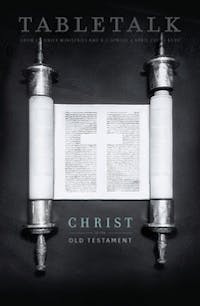
Request your free, three-month trial to Tabletalk magazine. You’ll receive the print issue monthly and gain immediate digital access to decades of archives. This trial is risk-free. No credit card required.
Try Tabletalk NowAlready receive Tabletalk magazine every month?
Verify your email address to gain unlimited access.
The default sin of the human heart is to put ourselves first. “It really is all about me!” was once a funny t-shirt slogan; it has now become a way of life. Unless preachers and Bible teachers are careful, the way we handle Scripture can actually feed this beast. We rush to application, consumed by the question, “How is this relevant to me?”
But the Bible is theocentric, not anthropocentric. It is more concerned to trace God’s ways — His character, purposes, and His cosmic redemptive plan (“For God so loved the cosmos”) — than it is to give modern believers character-building resource material (“be courageous like Daniel; lead like Nehemiah; with the faith of Abraham”).
We must start by remembering the overarching plot of Scripture. The Bible is remarkable: sixty-six books, dozens of human authors, fifteen hundred years in the making, various types of literature. But its grand diversity is held together by a golden thread, a single plot in three movements — creation, fall, redemption — that is unveiled in its first few pages. This plot establishes the crucial backstory to the coming of Jesus Christ. A backstory introduces characters, establishes relationships, and defines key terms. In this case, the Old Testament introduces Jesus, defines His work as Messiah, and establishes the theological framework for understanding God’s redemption.
A brief glance at two Old Testament festivals is illustrative. The first is Passover, the familiar feast that anchored the exodus. Some of its features (the angel of death, blood on doorposts, a meal eaten in haste) are well known parts of the story. Others are not. What matters is that all are shadows of the coming Christ.
Jesus ministered in a Jewish context, keeping the Passover with His disciples. But He took pains to show that the customs were more than context; they defined Him.
The Torah required selected lambs to be put on public display for four days (Ex. 12:3–6) to verify that they were without blemish. Jesus, following the triumphal entry, presented Himself in the temple for that exact period, for that very purpose. He submitted to testing by the Pharisees, Herodians, Sadducees, and scribes (Mark 12:13), tried before the Sanhedrin and Pilate, He proved spotless.
“This is my body” and “this cup is a new covenant in my blood” are Lord’s Supper keystones, but they were spoken during the Passover Seder. The meal — and the true exodus — are found in Jesus.
Passover was both a family and a communal feast. The lamb chosen “for the nation” was staked out in the temple courtyard on Passover at 9 a.m, and slaughtered publicly at 3 p.m. So was Jesus — nailed to the cross at 9 a.m., He died at 3 p.m., just as the four-footed beast died in a liturgy that concluded, “It is finished!”
Why are such details important? Because the point of Jesus’ death — contra pop theology’s selfish twist — is not merely how much physical pain He endured for me. It is, rather, what God accomplished by His death. The answer is found in Passover imagery. The Passover story (Ex. 12:2) began with strange words: “This month shall be for you…the first month of the year.” With Passover, God reset Israel’s calendar. Her old life as slaves was ending, a new life as sons beginning. Jesus’ death announced the same, but on a grander scale. Paul declares, “We have been united with him in a death like his” (Rom. 6:5). But he also exults, “Death is swallowed up in victory” (1 Cor. 15:54). Death with a capital “D” — not only personal physical death, but sin’s devastating reign over the first Adam’s world (Rom. 5:12–21) — was defeated in the cross of Christ.
If death’s reign was defeated in the cross, where dawns the new? It bursts forth in Jesus’ resurrection on the Feast of Firstfruits. This feast’s Old Testament roots were agricultural: early sheaves were brought to the tabernacle to share God’s bounty with the poor and aliens. But the feast always tilted Israel forward, rehearsing the day when all of life would be “very good” again as it once had been.
Paul uses festal language to explain this (1 Cor. 15:20). As Jesus’ death conquered death, so, too — as the second Adam — His resurrection dawned a new creation, a kingdom of grace (Rom. 5:21). Christ is the “firstfruits” of this new world. Raised with Him, we, too, who “have the firstfruits of the Spirit” (8:23), are the firstfruits of the new creation (James 1:18).
Thus the Old Testament Feast of Firstfruits is the ground of a vigorous and practical New Testament eschatology (view of the age to come).
These are only two brief examples; there are many more feasts, countless temple practices, and narrative stories that serve to rehearse the redemption that would come in Jesus. A gospel shaped by the rich Old Testament backstory is evangelistically more compelling, for it honors the cohesive unity of Scripture. And such a gospel produces disciples with a healthier self-image: they resist the default sin of putting themselves first and learn to deny themselves and follow Him.
